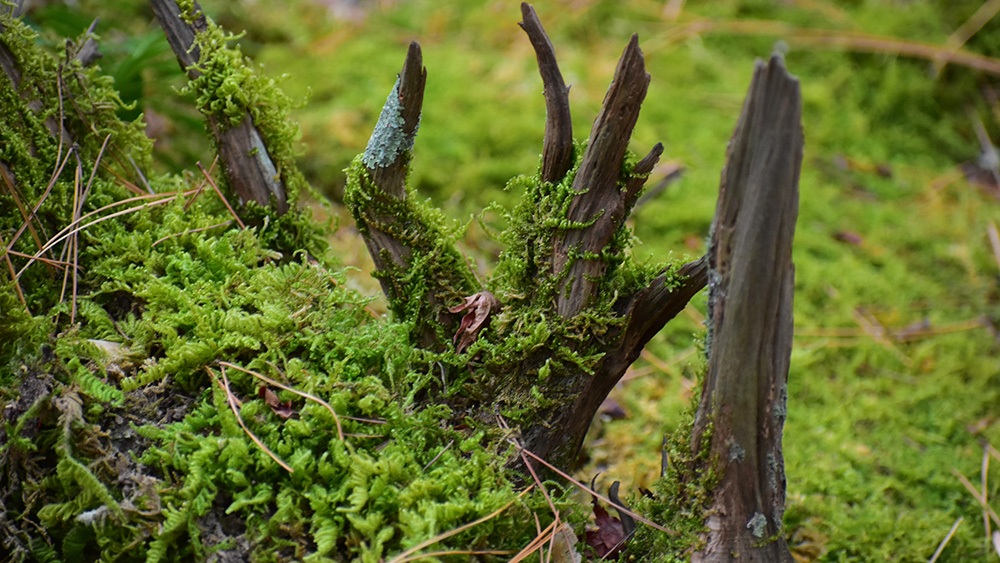Growing a New Interpretative Moss Garden in the Culberson Asiatic Arboretum
By Paul Jones, Curator of the Culberson Asiatic Arboretum
Mosses are a familiar though often overlooked plant component of almost every landscape globally, be it fire moss (Ceratodon purpureus) filling the cracks of sidewalks in the busiest cities, or hypnum moss (Hypnum cupressiforme) sharing with lichens the shady trunks of trees and boulders in our local parks and forests. Schistidium antarctici has adaptations that allow for months of survival beneath the snow and ice of rocky Antarctic shorelines, and feather moss (Hylocomium splendens) thrives on Alaskan tundra. Even the aridity of the world’s deserts has been conquered by steppe screw moss (Snytrichia caninervis).
The fossil record suggests that mosses were among the first land plants. Today, the number of moss species ranges to upwards of 12,000 or more, with 600 or so residing in North Carolina. Here’s a fun fact: if you gathered all the world’s mosses into one common mass, it is estimated that the square miles of coverage would be about the size of Canada! However, abundant though mosses may be, many people know little of their diversity, life history, ecological importance and potential for use in beautiful landscapes. A part of the mission of Duke Gardens is to deepen the public’s connection to the natural world through transformative learning opportunities. When the children of the late Barbara and Irwin Kremen approached us about creating a moss display to honor their parents, a latent idea of an interpretive trail to further the public’s appreciation of mosses became a reality.


Local author and poet Barbara Kremen joined the Garden’s staff as a volunteer in the late 1990s. She came with a mission in mind—that a display celebrating the beauty and landscape potential of mosses would be assimilated into the growing collection of herbs, trees and shrubs in the Culberson Asiatic Arboretum. The idea was a natural fit, and readily embraced. After a brief period of trial and error, a venerable old white oak sheltering tree-skirt moss (Anomodon attenuatus) and common fern moss (Thuidium delicatulum) at its base was deemed a suitable venue to expand upon. And expand we did. With permission, samples were collected from Duke Forest, from neighbors, from roadsides and from Gardens’ volunteers like Sally Boesch, whose family owns many acres of forest near Bahama, N.C. Sally was also actively involved in “planting” and establishing the new moss garden.
Around this time Barbara, a lifelong learner, reached out to Duke bryologist Dr. Lewis Anderson for help identifying, and learning to identify for herself, the increasingly diverse moss collection. Another fun fact: quite fittingly, Dr. Anderson was honored by one of his former students with the naming of the eastern North American endemic spoon-leaved moss, Bryoandersonia illecebra. The translation of Latin illecebra means “alluring” or “attractive”, which well describes this beautiful species resembling a greenish or golden colored shag carpet. It is among our favorites for landscape use.




In the summer of 2010, a sudden afternoon storm toppled the 180-year-old white oak under which our moss garden grew, resulting in the loss of much of our efforts. The sunshine on that space now being too harsh for moss, a shady north-facing woods’ edge nearby was chosen as a replacement site, and through the generosity of longtime Gardens’ friend and volunteer Kathleen Smith and her family, development of a new and more elaborate moss garden was soon underway. In December 2012, in collaboration with the North American Japanese Garden Association, we organized a regional workshop and initiated the new site with the guidance of guest leaders Katsuhito Nakasone, landscape designer from Toyama, Japan; Sadafumi Uchiyama, Curator of the Portland (Oregon) Japanese Garden; Masashi (Mike) Oshita, a classically trained Japanese landscape designer from western North Carolina; and local stone mason and artisan Brooks Burleson. Experts shared their knowledge about how to envision a moss garden, choose and prepare a site—including how to incorporate stones and boulders – and locate resources. Participants were given a “hands-on” opportunity to contribute to planting the newly reborn garden. Moss begets moss, and soon thereafter throughout the Arboretum, niches of existing moss were being cared for. Quickly realizing that the number of hands necessary for moss grooming needed to grow, in 2013 we recruited volunteer and Master Gardener Flora O’Brien into our fold. Today Flora leads a dedicated team that cleans and refreshes our “necklace” of moss displays.
In 2022, Barbara Kremen’s daughter Claire contacted us about giving a gift to Duke Gardens in memory of her parents, to fund, along with her brother Adam, a project in which mosses would be the centerpiece. We proposed creating an interpretive trail through an undeveloped wooded hillside adjacent to the moss garden beneath the former white oak that Barbara had tended many years earlier. This newest of our endeavors with moss would feature a diversity of mosses growing on a variety of substrates—stone, earth, live wood, dead wood, etc.—with interpretive signage providing the visiting public, especially children, with basic information about mosses, their anatomy, life cycle and ecological importance. Now a reality, the mossy trail honoring Barbara and husband, former Duke professor of psychology Irwin Kremen, winds around mature native pines, tulip poplars, sourwoods and white oaks, many of which were already supporting mosses such as feather moss (Brachythecium sp.) and pincushion moss (Leucobryum albidum) on their trunks. Ferns and small woodland wildflowers are added as companion plants. Carefully and naturalistically placed among the trees are 25 tons of moss and lichen-encrusted boulders. A small rocky seepage was created to display species such as sphagnum, which prefer to grow in or around fresh water.


Mosses matter. To tell their story, three massive cut-sandstone slabs are placed along the trail to provide space for rotating displays and interpretive materials, and to share additional fun and important facts, like:
Mosses are servants to other forms of life on Earth, benefiting natural ecosystems and climate in numerous ways. For example, mosses are among the first plants to recolonize damaged habitats after events like forest fires, helping to retard erosion and, because of their capacity for water retention, aiding recovery and regrowth. A 2023 study reported in the journal Nature Geoscience concluded, “Moss-covered soil not only exhibited enhanced carbon storage but also possessed heightened levels of vital nutrients, accelerated rates of organic matter decomposition, and fewer instances of soil-borne plant pathogens on average compared to plain, mossless soil.” The storage of carbon by mosses through carbon dioxide uptake is estimated in the billions of tons, a significant contributor to lessening greenhouse atmospheric gases.

And: Mosses are important to many animals and insects for food, shelter and nesting materials. The primary diet of the American pika is moss, and in winter moss is a staple for foragers such as caribou in northern climes. Closer to home, chickadees and robins are just two of several familiar backyard birds that use moss to line their nests. Robins are also voracious hunters when it comes to mining the cache of worms, larvae and small insects that inhabit the cool, moist moss environment. Indeed, after a day of robin activity, our fine-tuned moss displays look bedraggled, to say the least. (Thankfully volunteer Flora O’Brien and her team have the patience and perseverance necessary to look robins in the eye and say, “Hit me with your best shot.”)
A final fun fact: One question that the Gardens staff has been asked more than once over the years is, “How do I get rid of moss in my lawn?” Perhaps this new display will prompt some to reconsider, and instead ask, “How do I promote and care for the mosses in my garden and get rid of grass!”

Entrance to the new Interpretative Moss Garden dedicated to Barbara & Irwin Kremen.
Questions?
Please contact us at gardens@duke.edu.
